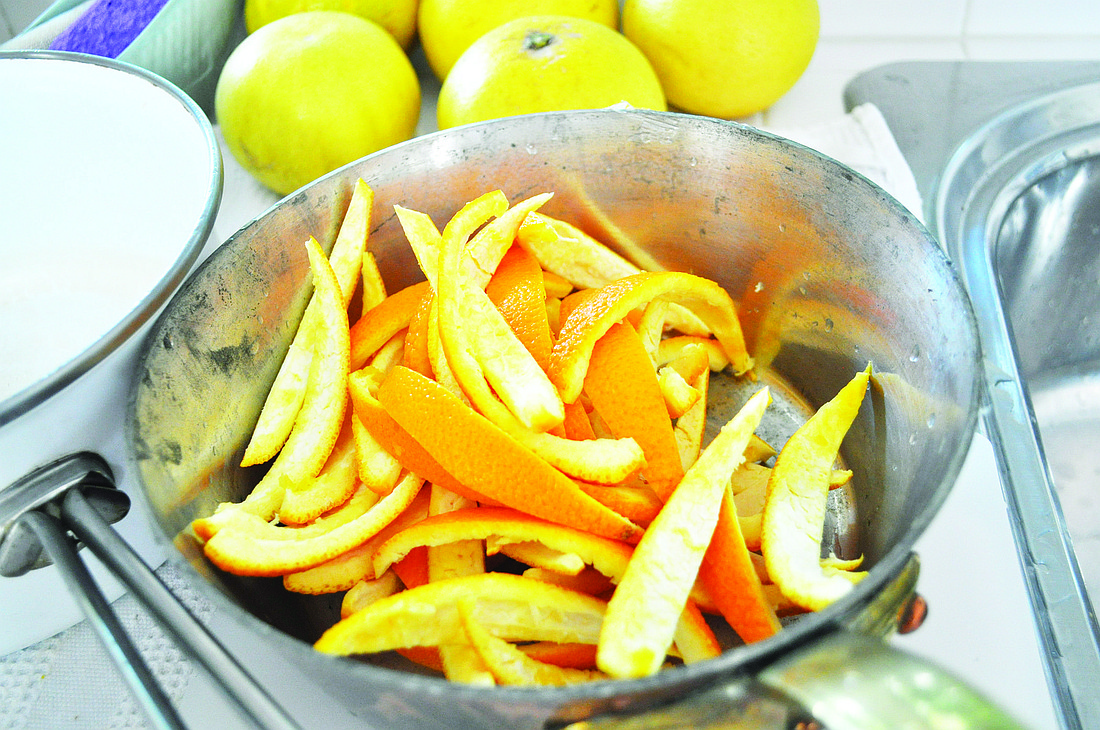- April 17, 2024
-
-
Loading

Loading

Citrus season is one of the great joys of living in Florida, especially for those blessed with a tree or two in the backyard. A special pleasure is making candied citrus peel. It takes focus and some patience, but the ingredients couldn’t be simpler, and there is nothing challenging or complicated about the method.
This recipe has been in my family for nearly 40 years. It started with directions that came in the form of a 15-cent air letter to my sister, Sara Alexander, in 1972, when she was living on the Rue D’Alesia, in Paris.
Alexander has refined the directions based on her experience with California fruit, and I have amplified them based on my own testing for this column, by using grapefruit from my own tree and store-bought oranges and lemons. Here they are for you to try, especially if you have access to local, homegrown fruit. Enjoy!
Candied citrus peel
Ingredients:
Per medium grapefruit or large orange:
1/2 cup water
1/2 cup sugar
Additional sugar for coating
Prep
If the fruit is store-bought, scrub vigorously with a brush to remove any vegetable wax or other coating.
Just rinse if the fruit is from your own trees.
Cut lengthwise into quarters (or sixths, if fruit is large). Slide your thumb under the peel at one end of the piece, and gently separate the peel from the flesh. Reserve fruit for another use, and use scissors to cut peel into strips that are one-quarter-inch to one-third-inch wide.
Blanch
This takes out the bitterness. Put peel in a large saucepan, cover with cold water, bring to the boil, and cook one minute. Drain, rinse, repeat. Then repeat again. After three blanchings, taste a bit of the peel before draining. If it’s still bitter, repeat the process one or two more times. Otherwise, continue to boil until the peel is just tender when pierced with a knife, usually within 10 minutes. Better yet, bite a piece. Drain.
Candy
Combine sugar and hot water and cook over medium heat, stirring until sugar is dissolved and brushing sugar crystals from the sides of the pan with a pastry brush. Add blanched peel, and cook until the peel is translucent and most of the syrup is absorbed; watch closely near the end of cooking to prevent burning. Put strips on a rack over waxed paper. Let dry thoroughly. Plan on at least four hours; overnight is not too long.
Finish
Roll strips in a shallow bowl of sugar. Some recipes call for “superfine,” but we prefer the regular kind. Return them to the rack for an hour or longer so that the sugar can set. Optional: Melt chocolate (grated or small pieces) in a heat-proof bowl over boiling water. Dip one end of each strip into melted bittersweet chocolate. Return to rack until chocolate is firm.
Store
Layer with waxed paper in a plastic container with a tight cover. If you want the chocolate to stay glossy, refrigerate the peels. Otherwise, the peels will keep for several days at room temperature.
Field notes:
You can do this with grapefruit, orange or lemon peel. Grapefruit is the hands-down favorite. Alexander tested pomelo and found them too thick and not as nice in flavor.
Homegrown fruit yields superior peel, no doubt for a variety of reasons, including freshness and cultivars bred for taste versus ability to withstand rough handling in shipping or storage.
Different recipes call for different proportions of sugar-to-water. We find that a 1-to-1 ratio consistently works well, but if your end result is not sufficiently sweet for your taste, you can increase the sugar.
Four ounces of chocolate is sufficient for two grapefruits or three large oranges.